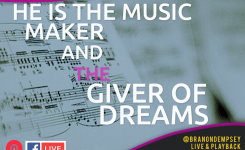Drums, WTTU Special Public Post
“Drums In Worship” (Show #144) | 11-15-17
2 min read | 30m Show
Drums in Worship
As a worship band leader, drums can be a powerful tool and often the backbone of the band, but not all churches use drums in worship, for a variety of reasons.Learn how to use drums effectively in worship, and how to introduce drums if they are new to your church.
11-15-17 WATCH SHOW #144
Rhythmic Blessing or Holy Terror
Denominational and theological differences between churches are as weak as sewing thread in comparison to the divisive question of drums in a worship service. Where some congregations see a method of regulating tempo and establishing new musical styles, others envision a source of noise and an infiltration of secular values.Should churches incorporate percussion instruments into their musical compositions? If so, how should appropriate use be determined, and by whom? Is an acoustic drum set superior to an electronic one? Is “drum tuning” an oxymoron? Let’s find out.
Rhythm, melody, and harmony make up the triad of music. Just as a stool must have three legs to function as a stable structure, so must music include all of its three elements to form a cohesive unit. Music without a separate percussive presence must extract rhythmic value from the melodic and harmonic instruments. Music structured in this way creates a subservient role for the rhythm and emphasizes the song’s melody and harmony.
Traditional hymns often take this approach and, in the process, create in the worshipper’s mind a precise concept of what “church music” is, or more importantly, is not. The hymn author probably did not intend to define the character of church music for all time; he or she simply sought to edify God in the style prevalent in that period. The issue then becomes determining the line of demarcation between music that is offensive to those worshiping and music that impedes on a cultural bias toward familiar musical styles.
In The Forefront
Current musical culture has once again embraced the rhythm section and thrust it into the forefront. To mirror this shift, some churches have brought percussion instruments into the sanctuary with varying degrees of acceptance. Each congregation’s selection of rhythm instruments typically parallels the current doctrinal position of that local body.Transition to drum instrumentation rarely begins with a full set of drums; instead, an initial foray is made into keyboard-based sounds, through hand percussion, then orchestral percussion, and finally to a stage drum set. Properly introducing each step at the right time is crucial to creating rhythmic progress without causing a percussive derailment.
Modern digital pianos, synthesizers, and even home keyboards contain a wonderful selection of drum and percussion sounds. A keyboardist may simply call up an appropriate preset sound and play along with the choir and organ, adding just the right amount of rhythm without becoming a noticeable element. If exercised with discretion, the “phantom drums” will pave the wave for further instrumentation, usually in the form of hand percussion devices.
Shakers, guiros, bongos, and, yes, tambourines are inexpensive instruments that can add marvelously to a worship experience. Companies such as Latin Percussion (LP) and Remo make these items in a bewildering array of diversity. Of course, there is nothing worse than a rhythm instrument played out of time or too loudly, so training is essential to realize the product’s benefit.
Many churches incorporate orchestral accompaniment for choir and solo numbers, so the addition of cymbal, triangle, and timpani can be accomplished without causing major disruption. Again, the key to success lies in constrained use of the instrument by a trained player.
[ctt template=”6″ link=”7Pl1I” via=”no” ] Praise him with sounding cymbals; praise him with loud clashing cymbals! Let everything that has breath praise the LORD! Praise the LORD! (Psa 150:5-6 ESV)[/ctt]
Overwhelming Spectacle
Once the ladder of progression has been scaled, the church is ready to position a drum set on the platform. As well prepared as the congregation may be, nothing will equip them for the imposing sight of masses of large drums surrounded by what looks like a dozen stands, each holding a bright cymbal. The spectacle is so overwhelming that it even looks loud. Bringing out only the snare drum and hi-hat cymbal the first Sunday can effect a better introduction. Later, the bass drum may be introduced, followed by the rack and floor toms at a special musical event when the stage is filled with other instruments, making the additional drums less noticeable. Thus, the drum set can safely reside on the same platform as the pastor’s podium. The next question to be addressed is which drums are appropriate for a worship environment. The choice of drums falls between a traditional acoustic set and a state-of-the-art electronic set. While both versions have compelling virtues, the selection generally rests on the needs of the church. If the room is an acoustic nightmare, with problematic reflections and poor intelligibility, and the drummer is incapable of moderating the playing level, an electronic set is the only choice, due to its ability to be controlled from the sound booth.
However, if the room is acoustically reasonable and the drummer is willing to play with restraint, an acoustic set will provide the better outcome since even the best electronic sets fail to deliver the nuances associated with an acoustic set. Manufacturers of acoustic drums hold tradition in high regard and are averse to change. The stalwarts of the industry, Ludwig, Drum Workshop, Pearl, Tama, and Yamaha have embraced incremental improvements to address the conservative nature of the buying public.
A focus on innovation has been in the electronic field. To this point, the Roland V-Drum system is the de facto standard in churches, with Yamaha, Alesis, Pintech, and ddrum all making great strides in performance. The primary mistake made in selecting an electronic drum set is the failure to include the drummer in the process. Having an electronic drum set thrust into one’s hands on Sunday morning does nothing to ingratiate the technology to the user.
Coming To A Decision
Before the decision is made, everyone involved should be given the opportunity to voice an opinion. The church leadership should then come to a decision with special consideration given to the drummer’s perspective.Instead of replacing the acoustic drum set, the drummer could try using Vater Acousticks drumsticks that provide the rigidity of dowel construction with the reduced volume level of Blastix tips. Additionally, Mufflrs, which are acoustic foam rings, may be mounted to reduce ringing. Finally, congregations can place clear Plexiglas panels made by ClearSonics around the drummer to reduce volume further.
Recap
Drums in worship settings can provide an outstanding supplement to the standard instrumental palette while allowing rhythm players in the church an outlet for their talent. If the percussion items are carefully selected for the application, incrementally introduced to the congregation, and made an integral part of the worship experience, true blessings will abound. Drums are simply another tool—their benefit derives from appropriate usage.Kent Morris is recognized for his church sound training abilities. He has more than 30 years of experience working with A/V, has served as a sound mixer for several noted performers and is a product development consultant for several leading audio manufacturers.
@kentmorris1@BranonDempsey @worshiptt @WorshipTTU
Want to watch MORE Worship Team Training Videos?
Not a WTTU Member, or Choose to Upgrade? Update Now

Worship Team Training® Is your worship team stuck? Want worship leading to be better? Want to be free? We can take you there. Inspire, create and transform the leading of worship. Get a WeekendWorkshop
Copyright 2017 Worship Team Training®










